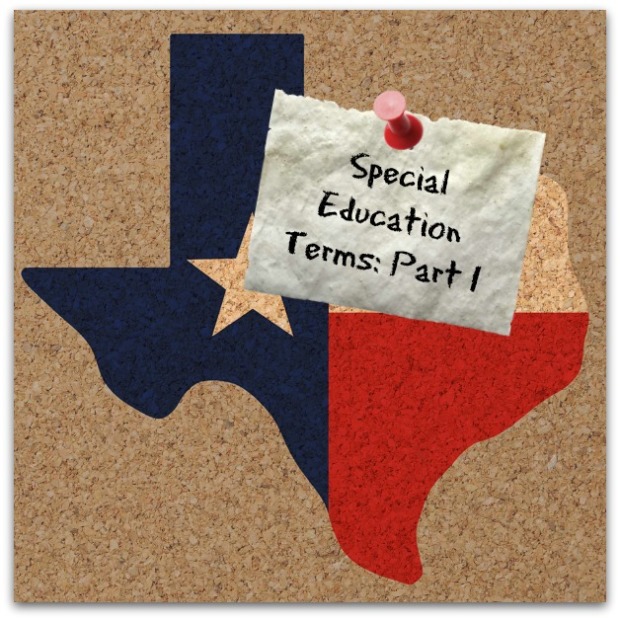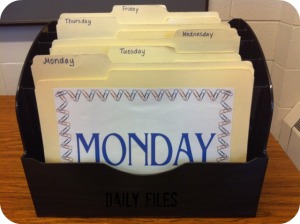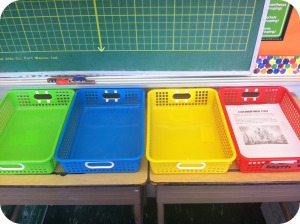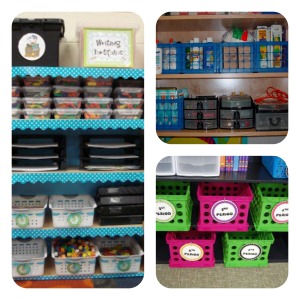Texas Special Education Terms: Part 1
“Make sure that you base your IEP on the TEKS, and don’t forget about OT/PT.”
If you have ever listened to a group of Special Education teachers for any length of time, you might start to wonder if they developed their own language. Special Education terms can vary by state, or even between districts. It’s not always easy to keep everything straight, so I have put together a short list of commonly used Special Education terms that I thought might be helpful for teachers, parents, or anyone interested in finding out more about Special Education. I will post new terms as the year goes on. Here are a handful of terms to get you started.
- ARD – These letters stand for Admission, Review, and Dismissal. The purpose of the ARD meeting is to provide an opportunity for parents and educators to discuss and develop an educational program for the student (the I.E.P.) The ARD must take place at least once each school year, although it can happen anytime decisions about the student need to be made. The group of people who make educational decisions about the student are known as the ARD committee. Participants in this committee can include, but are not limited to: the student, parents and/or legal guardians, the student’s case manager, the Special Education coordinator, general education teachers that work directly with the student, speech therapists, occupational therapists, physical therapists, parent advocates, and social workers.
- IEP – Individual Education Plan. This is the legal written document developed for an individual identified as having a disability according to IDEA. It is the written plan that details the student’s present level of academic achievement and functional performance (PLAAF), results of state and district-wide assessments, transition plan (begins at age 15the special education goals, services and related services that are to be provided to the individual student. Parents and school staff work together to develop the IEP at the ARD meeting. The IEP must be reviewed at least annually.
- SPED or Spec. Ed. – Special Education. Special Education services are provided at no cost to parents, to meet the unique needs of a child with a disability, including instruction conducted in the classroom, in the home, in hospitals and institutions, and in other settings; and instruction in physical education. This term may be used in reference to the “SPED teacher” or “SPED Department”. Best practice is moving away from this term, especially when used to refer to “SPED students”. It is more appropriate to use person first language, such as ‘students with Special Education needs’ or ‘student receiving Special Education services’. TEA provides an excellent side-by-side comparison of federal regulations, the Commissioner’s/SBOE Rules, and Texas state laws.
- Gen. Ed. – General Education. The general education classroom and curriculum. In Texas the general education curriculum is the Texas Essential Knowledge and Skills, or the TEKS.
- IDEA – Individuals with Disabilities Education Act, also known as Public Law 94-142. First passed in 1975, this law established the right of school-age students with disabilities to receive “free appropriate public education”, also known as FAPE. The law was amended in 1996 to include preschool-aged children with disabilities ages three through five. Essentially, this law provides the minimum requirements each state must meet in order to receive federal special education funds.
- LRE – Lease Restrictive Environment. A legal mandate of the Individuals with Disabilities Education Act, IDEA, this term refers to the right of every student to be educated with non-disabled peers to the maximum extent appropriate. This is one of the most controversial terms in the IDEA law. Texas interprets the Least Restrictive Environment to be the general education classroom. Clear documentation of the discussion leading up to the decision and the outcome of the discussion must be placed in the student’s IEP if the ARD committee determines that the student will not participate in the general education classroom and/or curriculum for all or part of the day.
Let me know what terms you would like to see defined, and be sure to like my page on Facebook and share with other middle school teachers! Thanks!
Classroom Organization Tips
The school year is just around the corner. It is about this time every year that I start to really think about how I want to organize my classroom. I will be in a new classroom this year, and while some may be dismayed at the thought of changing classrooms, I always look at it as an opportunity to reassess my organization strategies. My biggest challenge is organizing myself in a way that is simple enough to maintain when the year really gets going. I have found some ideas around the web that are definitely worth a look. (There are some amazingly organized teachers out there!)
1. Daily work files: Create daily work files at the beginning of the week with lesson plans, all the copies you need, and any supplemental material. I did this last year, and it was a life saver. It is especially helpful if you switch classrooms during the day, or if you happen to be gone unexpectedly.
2. Have a place to put missed work. Teach students to be responsible for finding missed lessons when they are absent or out of the classroom by utilizing a system like this pocket chart, or an absent bin. (Of course, with all the engagement we will be doing in our classrooms, it will be hard to put it in a file folder!)
3. Color code your room. I am a visual person, so I love this idea! This middle school math and science teacher from To the Square Inch share her strategy for keeping things organized by using one color for each class, so that student can quickly locate their guided notes, supplies and know where to put their homework. Brilliant!
4. Make supplies accessible. If you use collaborative teaching groups in your classroom, this one is for you. We know that middle school students will take advantage of every opportunity to get out of their seats, so bring the supplies to them! I have also seen this done with crates that sit in the middle of each pod.
5. Crates, drawers, and containers…oh, my! You can’t have enough of these invaluable items in your classroom. If things have a designated location, they will have a better chance of making it back to that location. Let’s face it middle school teachers, we could take a lesson or two from our elementary friends when it comes to cute and organized, right? Kindertrips, Following my Heart to First (she used to be a 6th grade teacher!), and this amazing site about Getting Organized have some really creative ways to get your year started off right.
I hope you found something useful that you can incorporate into your classroom this year! Be sure to follow my blog here and on Facebook for more great resources and stories about middle school! If you are a Texas middle school teacher, I would love to add your blog to my collection, and have you contribute to this blog! Let’s connect!
















